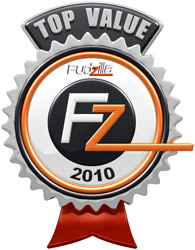Over
the past three decades, Seagate Technology has held a
tenured position in the industry for being accredited with high-performance
digital storage solutions in a large variety of consumer markets. From the mainstream
end-user to the hardware enthusiasts to the enterprise and professional
marketplace, Seagate has provided an abundance of product offerings across the
entire spectrum.
During these past thirty years in the world of
computing, magnetic storage capacity has increased at an exponential rate. The
emergence of Web 2.0 infrastructure and cloud computing have ushered in a new
era of data reliability for the world’s enterprise data servers and storage
solutions. As the world’s demand for increased storage capacity progresses into
the 2010s, its dependence on company-advertised reliability measures has risen
as well. Seagate is a company that many ardent enthusiasts in the information
technology business regard as having a highly dependable, honest and
trustworthy engineering workforce when it comes to data being stored on their
hard disk platters. Nevertheless, the company has asked many journalists,
including ourselves, to put the validity of these statements to the test and
prove to the enterprise world that its company ethics, product dependency and
engineering innovation have withstood the forces of time since its foundations
in 1979.

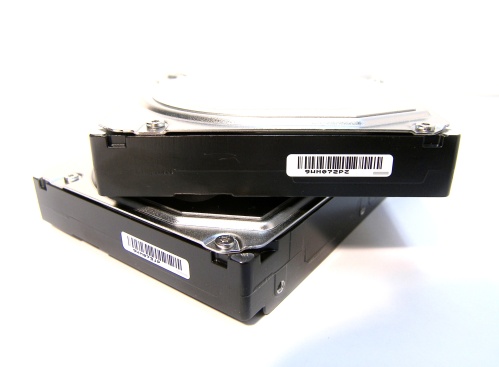
The company recently sent us two of its
fourth-generation Constellation
ES 2TB (ST32000644NS) drives designed for high-capacity storage, 24/7 operation and seamless enterprise integration. We have been presented these drives under the presumption that they would provide the most exceptional business-oriented sustainability in precious mission-critical environments similar to those found in HP, Nvidia, Microsoft and Google server storage rooms and database centers. As such, our hypothesis stands that these drives will be one of the most reliable magnetic storage SATA solutions on the market for any system builder or IT professional.
“The need for greater
storage capacity will continue to expand in multiple directions and dimensions,
but there will be an increasing scrutiny of all storage system purchases, with
an eye to decreasing power consumption, footprint, and cost per GB in
unprecedented ways,” said John
Monroe, a research vice
president at Gartner
Inc. “Performance will not be
ignored, but a flexible balance of capacity, cost per GB, power and speed will
become more crucial in fulfilling end-user storage demands at varied price
points.”
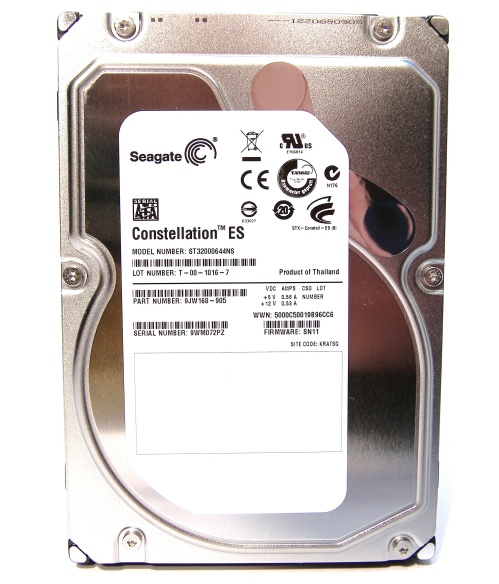
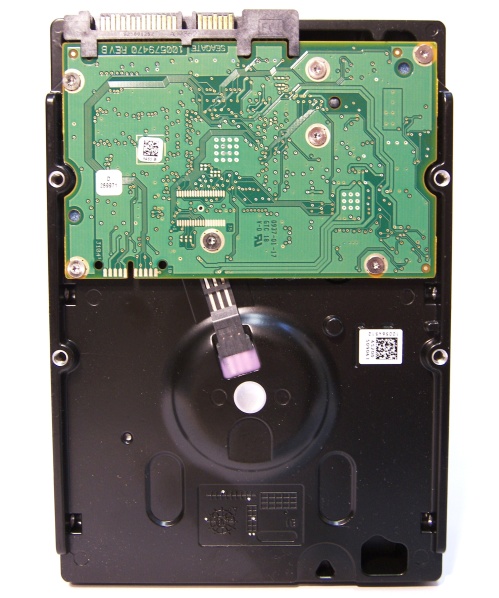
Nevertheless, while Seagate has advertised its
fourth-generation Constellation ES series drives to specifically appeal to
enterprise and professional marketplaces, we are inclined to believe that they
also hold a significant appeal to PC hardware enthusiasts who desire a
combination of incredible RAID0 performance at the benefit of having an
abundance of storage capacity. During our tests, we will measure both RAID0 and
RAID1 performance as it applies to performance-demanding customers and reliability-demanding
customers in different respective markets, and we hope to exemplify the
comparative advantage that these drives offer in both categories.
Pricing
and Specifications
While Seagate’s fourth-generation Constellation ES
drives have received a lot of press over the fact that they are the world’s
first 2TB enterprise storage solutions, there is much more be known about the
technology and architectural design behind these drives. “Constellation is a
much bigger deal than the capacity milestone,” noted Pete Steege, Global
Segment Manager at Seagate. We are inclined to agree with him in many respects.
The Seagate Constellation ES drives currently come in three capacities – 500GB,
1TB and 2TB – and are currently shipping in the SATA II 3Gbps interface with a
spindle speed of 7200RPM. We should note that Seagate representatives have told
us that models ST3500514NS (500GB), ST31000524NS (1TB), and ST32000644NS (2TB)
are new to the channel, just released and hard to find, with availability
favored towards reviewers and OEM partners.
The Seagate Constellation ES 500GB, 1TB and 2TB models
that we were able to find in stock are currently priced at $93.99,
$159.00
and $299.73
respectively, making the 2TB SATA model on review priced slightly above the 2TB
Barracuda XT 6Gbps SATA III drive that several news outlets have positively
critiqued these past few months (although the drive offers almost no performance advantage over its 3Gbps competition). In
comparison, Samsung currently prices its EcoGreen
F2 series drives at around $75
for 1TB and $99
for 1.5TB, while Western Digital currently prices its new Caviar Black series
drives at $69 for 500GB, $99 for 1TB and $300 for 2TB. For a more direct
comparison to our Seagate ST32000644NS 2TB drive, Western Digital prices its
enterprise-oriented 2TB RE4 SATA 3Gbps drive (WD2003FYYS)
at around $309.99.
In 2010, these are the prices to expect for 2TB drives sporting 64MB of cache,
proper RAID clustering support and enhanced power management designs for
large-scale server environments.
Seagate has also stated several times that
Serial-Attached-SCSI 6Gbps (SAS 2.0) versions of all three drives are currently
in production, and we can expect availability very soon. In the meantime,
however, this review will focus on SATA 3Gbps performance and should be an
indication that the currently shipping drives are more than sufficient for many
enthusiast users on the market. Model numbers for the SAS 2.0-interfaced drives
include ST3500414SS (500GB), ST31000424SS (1TB) and ST32000444SS (2TB) as well
as three Self-Encrypting Drive (SED) models numbered ST3500415SS (500GB),
ST31000425SS (1TB) and ST32000445SS (2TB).
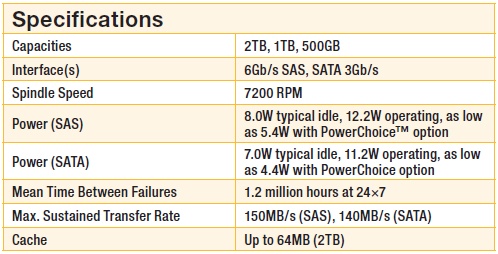
At the time of the original press announcement, the Constellation ES series was advertised as being the most
power-efficient magnetic storage drive series available on the market. Seagate
engineers went to work on a highly-efficient power saving feature dubbed
PowerChoice which “decreases power consumption by up to 54-percent for record
power savings in enterprise environments.” According to the product
specifications for the SATA interfaced drives, the PowerChoice feature is
capable of reducing overall power consumption from 7.0W idle down to around
4.4W idle. In comparison, the SAS-interfaced drives are advertised to run as
low as 5.4W with the PowerChoice option.
Testing
setup and hardware configuration
Our core
hardware setup consists of an EVGA X58 SLI Classified E759 motherboard,
an Intel Core i7 Extreme 980X Gulftown six-core processor at 3.60GHz and
6GB of Mushkin XP Series DDR3 1600MHz 7-8-7-20. Additional hardware
includes a SilverStone Strider 1500W power supply and two Samsung
Spinpoint F1 750GB HE753LJ RAID Edition drives.
While some may argue that the configuration listed above is completely overkill for an undemanding, rudimentary hard drive performance and reliability evaluation, the system is our primary evaluation unit and should reduce the number of bottleneck variables to as low as possible. As such, it provides a more than adequate environment for our Seagate Constellation ES 2TB drives in both RAID0 and RAID1 configurations.
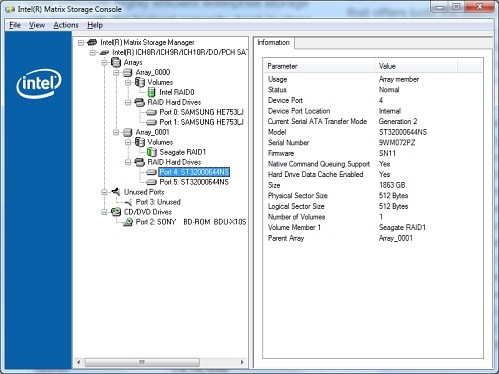
SeaTools for Windows is a
comprehensive, easy-to-use diagnostic tool that allows users to quickly
determine the condition of the disc drive in an external hard drive, desktop or
notebook computer. In addition, it includes several tests that will examine the
physical media on any compatible Seagate or Maxtor disc drive and any other
non-Seagate disc drive.
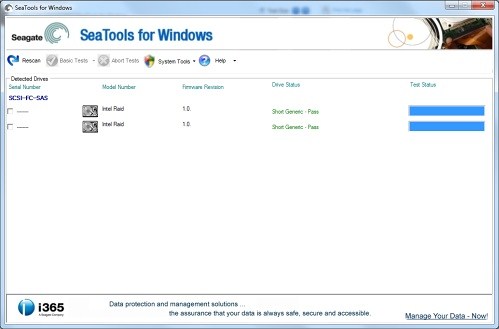
The drives passed the
SeaTools Short Generic tests for “outer edge,” “inner edge” and “random read,”
but we should note that the noise levels on these drives are above average and even
somewhat excessive. While Seagate has managed to design some very
power-efficient and eco-friendly enterprise drives, it appears to have
sacrificed some audible noise value in the process. Although we have no
professional decibel measuring equipment on hand to properly quantify the
audible variables, we can insist that on a subjective level, these drives
operate close to the 55dB range when situated outside and apart from the rest
of the test system in an isolated scenario. In comparison, the Samsung
Spinpoint F1 RAID Edition drives operate at a consistent 45dB range during idle
desktop use and under load-intensive file transfers.
Crystal Disk Benchmarks
The next application we
used to test throughput performance was Crystal Disk Benchmark. The utility has
been around for a little over a year and a half and has provided a convenient
array of rudimentary read/write information about hard disks put to the test
against it.
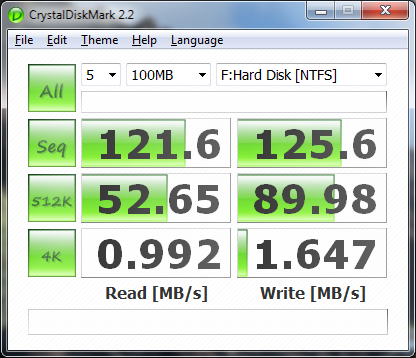
2x Seagate Constellation
ES ST32000644NS 2TB drives in RAID1
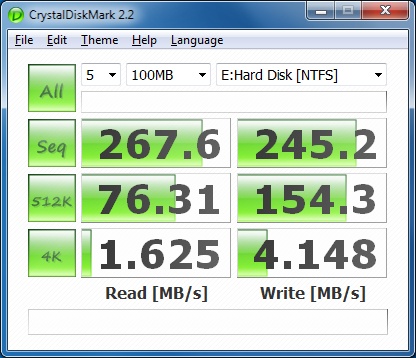
2x Seagate Constellation
ES ST32000644NS 2TB drives in RAID0
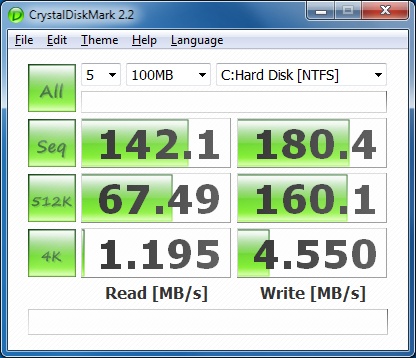
2x Samsung Spinpoint F1
HE753LJ drives in RAID0
Based on the results, the
Constellation ES 2TB drives gained a 95% sequential write increase and a 120%
sequential read increase going from RAID1 to RAID0 configurations. Meanwhile, the
improvement between the Samsung Spinpoint F1 HE753LJ drives in RAID0 and the
Constellation ES drives in RAID0 resulted in a 35% sequential write increase
and an 88% sequential read increase for the latter drives.
HD Tach Benchmarks
We also decided to include
HD Tach results between a single Constellation ES drive, a pair of Constellation ES drives in
RAID0 and the Samsung Spinpoint F1 RAID Edition drives in RAID0.
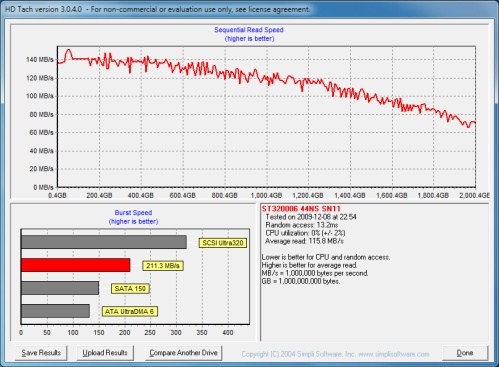
Seagate Constellation ES ST32000644NS
2TB single drive
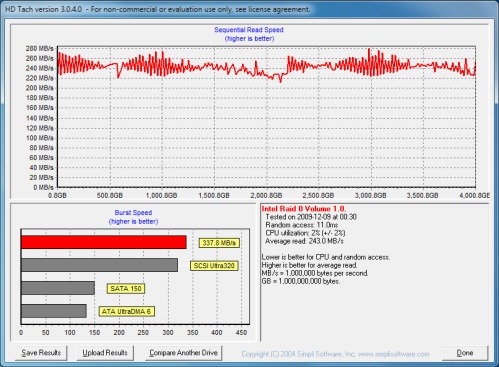
2x Seagate Constellation
ES ST32000644NS 2TB RAID0
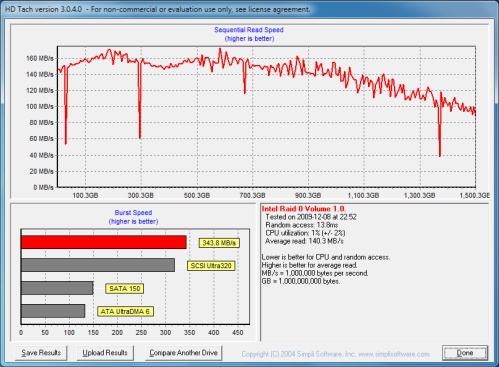
2x Samsung Spinpoint F1
HE753LJ RAID0
The first thing we want to
note is the reduction in latency access times between a single Constellation ES
and a pair of them in RAID0. Latency was reduced by roughly 2.2ms with striping
enabled, and average read speeds increased by roughly 110 percent. In
comparison, the Samsung Spinpoint F1 HE753LJ RAID Edition drives produced an
increased latency access time of 2.8ms over the Constellation ES drives in
RAID0 and performed roughly 43 percent lower in average read speeds.
HD Tune Benchmarks
For our third set of tests,
we decided to run HD Tune, a popular hard disk utility with the ability to
measure drive performance, scan for errors, check drive health status using
S.M.A.R.T. monitoring and much more. For this occasion, we wanted to use it as
an additional verification utility for determining the accuracy of our hard
disk performance data.
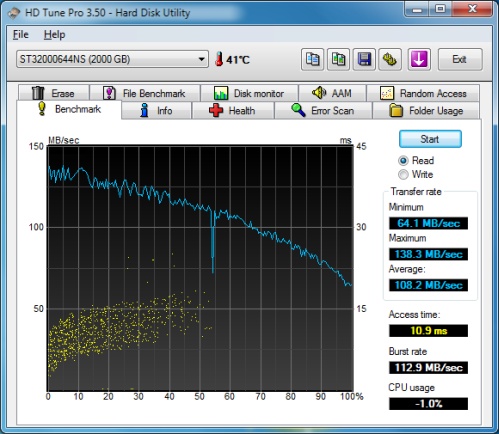
Read Benchmark - Seagate
Constellation ES ST32000644NS 2TB single drive
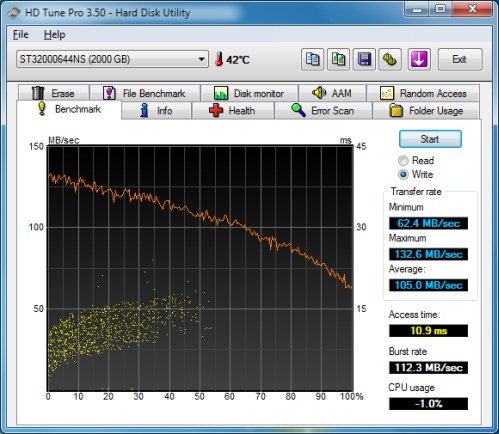
Write Benchmark – Seagate Constellation
ES ST32000644NS 2TB single drive
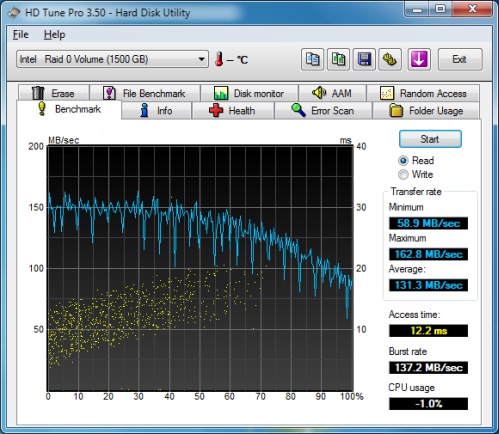
Read Benchmark – 2x Samsung
Spinpoint F1 HE753LJ RAID0
HD Tune reports that a
single Constellation ES 2TB drive was able to manage a 105MB/s read speed
average and a 108MB/s write speed average with 113MB/s Burst Rate and 10.9ms
access time. In comparison, a pair of Samsung Spinpoint F1 HE753LJ RAID Edition
drives in RAID0 were able to manage a 131MB/s read speed, 137.2MB/s Burst Rate
and 12.2ms access time.
Another important factor
to note about these drives is their tendency to run very hot. We have been
operating these Constellation ES drives in both RAID0 and RAID1 test
configurations for the past two and a half months, and with almost every system
shutdown we would note that the drives were significantly warmer than we had we
had expected for enterprise-class products. Although the Constellation ES Product
Overview specifications page does note that “these nearline drives optimize
3.5-inch chassis performance with the lowest power draw and run cooler in
high-temperature environments,” it seems that they still run hot in consumer-oriented
desktop situations when compared to the Samsung Spinpoint F1 RAID Edition drives.
Heat Buildup and Rotational Vibration
A recent
article written by Seagate
Technology storage expert David Szabados, Senior PR Manager responsible for enterprise storage, security, and future emerging storage technologies at the company, highlights the issue of rotational vibration in desktop and enterprise environments and its effects on data integrity. The article notes that the company has implemented numerous technologies over the decades in its multi-platter desktop and enterprise drives, including the Barracuda series, Constellation series and Constellation ES series, to negate the effects of rotational vibration. In particular, Seagate uses RV sensors as well as linear vibration sensors to compensate for any vibration that is generated from the drive. These sensors also cover environmental factors from outside of the drive, including cooling fans, chassis rigidity and other vibrational mechanisms. The company's larger capacity drives, including the Constellation ES 2TB, are built using a Top-Cover-Attach spindle motor that increases rigidity within any drive with a 4-disk configuration.
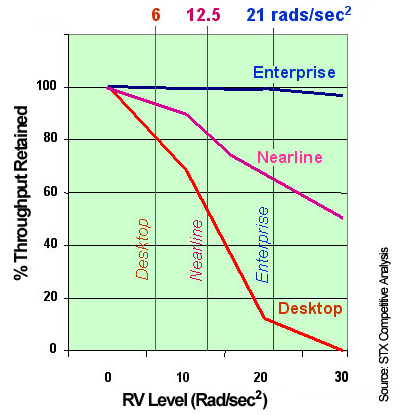
At first, we were a bit skeptical about the sustainable performance levels of these drives in relation to the amount of rotational vibration emitted during operation. Seagate notes, however, that when the rotational vibrations (RVs) increase beyond their specified tolerances, the performance of traditional desktop drives will drop dramatically, while enterprise-class drives will maintain consistent performance throughput under even moderately severe conditions. This led us to believe that while the drives may run hotter and produce more RVs than the Samsung Spinpoint F1s in comparison, the integrity structures that were engineered into the Constellation ES design framework give them a huge competitive advantage in enterprise environments where performance throughput is critical to sustainable operations.
Power
Consumption
One of the most important marketing points that
Seagate addresses throughout its Constellation ES enterprise storage ecosystem
is the PowerChoice
host-selectable power options. In theory, the feature is designed to tailor the
drive’s power savings settings for performance and power consumption via Set
Feature commands (on the SATA models) and via mode pages (on the SAS models). The
company implemented this feature to allow the drives to be flexibly configured
for optimal idle time thresholds. In other words, users are able to specify
exactly how long the drive’s command queue is empty depending on certain storage
application requirements. This is an ideal characteristic for high volume data
center environments where a mixed bag of applications are run on the same
drives during certain time slots throughout the day. Of course, the technology
wouldn’t be favorable if it didn’t have competition to live up to. In
comparison, Western Digital claims that its own proprietary Active Management
Feature can "monitor work load and automatically invoke idle mode whenever possible
to further reduce unnecessary power consumption.” The difference between the
two technologies is simply all about user control. With Seagate’s
implementation, the user is able to override the default PowerChoice timers and
manually configure them according to custom environmental variables. Western
Digital’s implementation, by definition, assumes itself to be a superior algorithm that is perfectly capable
of handling automatic power management.
Conclusion
Seagate has once again delivered a very robust and
highly reliable storage solution with its fourth-generation Constellation ES
series drives. With an engineering ethic built around providing exceptional
enterprise-oriented sustainability for high-volume database centers around the
world, we were presented these drives under the assumption that they would be
the absolute best-in-class for reliability measures. Indeed, they delivered on
this promise and went beyond our expectations by providing incredible RAID0
performance that we were not expecting to see. Although the Constellation ES
2TB drives tend to run quite hot and tend to produce more rotational vibrations
than the Samsung Spinpoint F1 RAID Edition drives we had for comparison, the
company has ensured that its RV sensors and linear vibration sensors will sufficiently
compensate for any vibrations coming from any outside environmental factors. In
addition, the inclusion of PowerChoice technology will ensure any IT managers
that these drives are fully configurable for a variety of application workloads
in the storage room and were engineered with mission-critical reliability particularly
in mind.
All in all, the Seagate Constellation ES ST32000644NS
2TB drive is currently the most reliable enterprise-class drive we have ever
tested. While the $300 dollar price tag may present the drive as a premium
product to some business professionals, it ultimately pays for the drive’s unparalleled
reliability and a continued investment into Seagate’s innovative product line
that continues to drive the storage industry forward at an incredibly rapid
pace.
